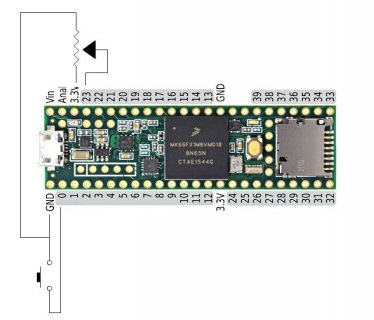Gripporillat
Well-known member
Hi everyone,
first of all, I'm absolutely new to this, this is my first teensy project, even my first microcontroller project ever. The last time I tried coding was php4 so I'm kind of new to coding as well
My final goal is to build a simple but kind of huge Midi controller. (71 analog and 31 digital inputs) I'd like to use the MIDIcontroller library because it seems very easy to use. I couldn't figure out yet how to do multiplexing with this library and I hope you can help me with that but first of all I did a little testing to check if I'm capable to build a very simple controller.
This is my circuit:

And this is my Code:
First of all: IT WORKS! YEAH! But I'm experiencing a little bug: I'm using a slide potentiometer and the lowest value I get from it is 1, not 0. Can anyone tell me why?
Thx in advance!
first of all, I'm absolutely new to this, this is my first teensy project, even my first microcontroller project ever. The last time I tried coding was php4 so I'm kind of new to coding as well
My final goal is to build a simple but kind of huge Midi controller. (71 analog and 31 digital inputs) I'd like to use the MIDIcontroller library because it seems very easy to use. I couldn't figure out yet how to do multiplexing with this library and I hope you can help me with that but first of all I did a little testing to check if I'm capable to build a very simple controller.
This is my circuit:

And this is my Code:
Code:
#include "MIDIcontroller.h"
byte MIDIchannel = 1;
const int buttonPin = 0;
const int potPin = A9;
// MOMENTARY buttons are the default. LATCH or TRIGGER may also be set
MIDIbutton button1(buttonPin, 0, MOMENTARY);
MIDIpot myPot(potPin, 1);
void setup(){
}
void loop(){
button1.send();
myPot.send();
}First of all: IT WORKS! YEAH! But I'm experiencing a little bug: I'm using a slide potentiometer and the lowest value I get from it is 1, not 0. Can anyone tell me why?
Thx in advance!

